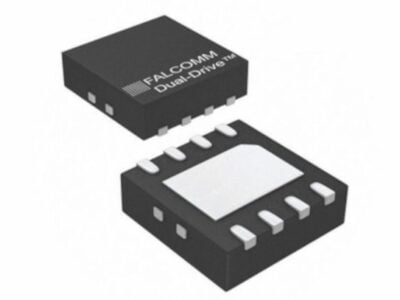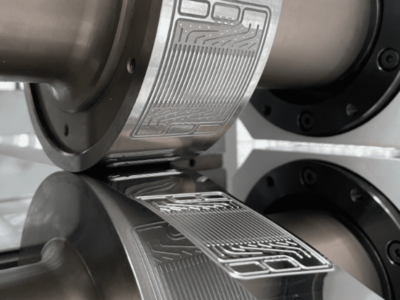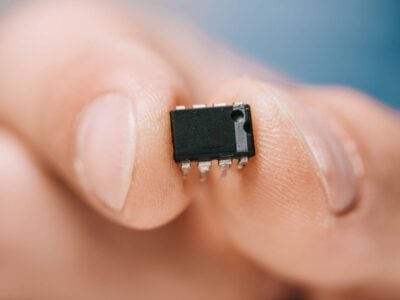
Acoustic RF amplifier points way toward smaller radio chips
While active functions in modern RF signal processors – such as amplifiers and mixers – are typically electronic and realized in semiconductor technologies, say the researchers, they can potentially be made smaller and better as acoustic devices – i.e., devices that use sound waves instead of electrons to process radio signals.
“Acoustic wave devices are inherently compact because the wavelengths of sound at these frequencies are so small,” says Sandia scientist Lisa Hackett. “Smaller than the diameter of human hair.”
However, until now, without the benefit of modern nanofabrication technologies, say the scientists, using sound waves has been impossible for many of these RF components. The last such attempts – made in the ’70s – performed too poorly to be useful. Boosting a signal by a factor of 100 with the old devices required 0.4 inch (1 centimeter) of space and 2,000 volts of electricity, while at the same time generating lots of heat, and requiring more than 500 milliwatts of power.
Sandia’s acoustic, 276-megahertz amplifier, however, can boost signal strength by a factor of 100 while measuring only 0.008 inch (0.2 millimeter) and requiring only only 36 volts and 20 milliwatts – demonstrating the vast, largely untapped potential for making radios smaller through acoustics, say the scientists. To amplify 2-gigahertz frequencies, which carry much of modern cell phone traffic, the device would be even smaller – 0.00003 square inch (0.02 square millimeter) – a footprint that would comfortably fit inside a grain of table salt and is more than 10 times smaller than current state-of-the-art technologies.
The researchers say they also created the first acoustic circulator, another crucial radio component that separates transmitted and received signals. Together, say the scientists, the tiny parts represent an essentially uncharted path toward making all technologies that send and receive information with radio waves smaller and more sophisticated.
“We are the first to show that it’s practical to make the functions that are normally being done in the electronic domain in the acoustic domain,” says Sandia scientist Matt Eichenfield.
Previous researchers, say the scientists, hit a dead end trying to enhance acoustic devices, which are not capable of amplification or circulation on their own, by using layers of semiconductor materials. For their concept to work well, the added material must be very thin and very high quality, but scientists only had techniques to make one or the other.
Decades later, Sandia developed techniques to do both in order to improve photovoltaic cells by adding a series of thin layers of semiconducting materials.
“I realized,” says Eichenfield, “that this work that Sandia had done to develop these techniques for essentially taking very, very thin semiconductors and transferring them onto other materials was exactly what we would need to make these [acoustic] devices realize all their promise.”
The Sandia researchers made their amplifier with semiconductor materials that are 83 layers of atoms thick – 1,000 times thinner than a human hair. Fusing an ultrathin semiconducting layer onto a dissimilar acoustic device took an intricate process of growing crystals on top of other crystals, bonding them to yet other crystals and then chemically removing 99.99% of the materials to produce a perfectly smooth contact surface.
Nanofabrication methods like this – collectively called heterogeneous integration – are a research area of growing interest at Sandia’s Microsystems Engineering, Science and Applications complex and throughout the semiconductor industry. While RF amplifiers, circulators, and filters are normally produced separately because they are dissimilar technologies, Sandia produced them all on the same acousto-electric chip.
The more technologies that can be made on the same chip, say the scientists, the simpler and more efficient manufacturing becomes. The researchers say their work shows that the remaining radio signal processing components could conceivably be made as extensions of the devices already demonstrated.
While converting mass-produced, commercial products like cell phones to all acousto-electric technology would require a massive overhaul of the manufacturing infrastructure, say the scientists, the technology holds more immediate promise for small productions of specialized devices. The researchers say they are now exploring whether they can adapt their technology to improve all-optical signal processing, too.
They are also interested in finding out if the technology can help isolate and manipulate single quanta of sound, called phonons, which would potentially make it useful for controlling and making measurements in some quantum computers. For more, see “Towards single-chip radiofrequency signal processing via acoustoelectric electron–phonon interactions.”
Related articles:
Adding or subtracting a quantum of sound
Quantum acoustics breakthrough opens door for more powerful sensors
‘Acoustic whirlpool’ device promises low-cost, in-field disease diagnosis
Millimeter-wave circulator on a chip holds promise for VR, self-driving cars
Novel material for surface acoustic wave filters boosts efficiency
 If you enjoyed this article, you will like the following ones: don't miss them by subscribing to :
eeNews on Google News
If you enjoyed this article, you will like the following ones: don't miss them by subscribing to :
eeNews on Google News




